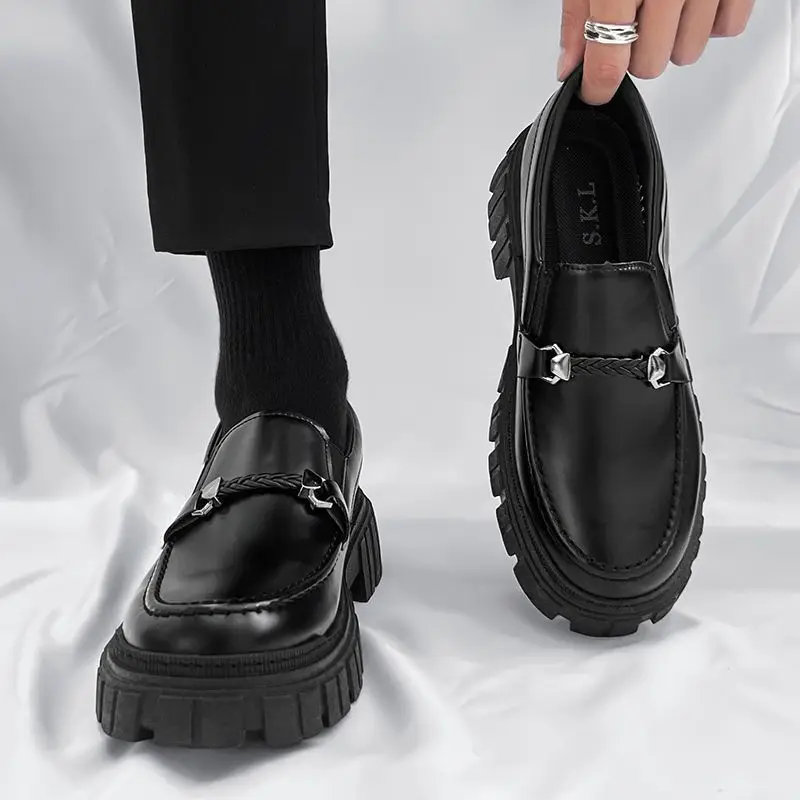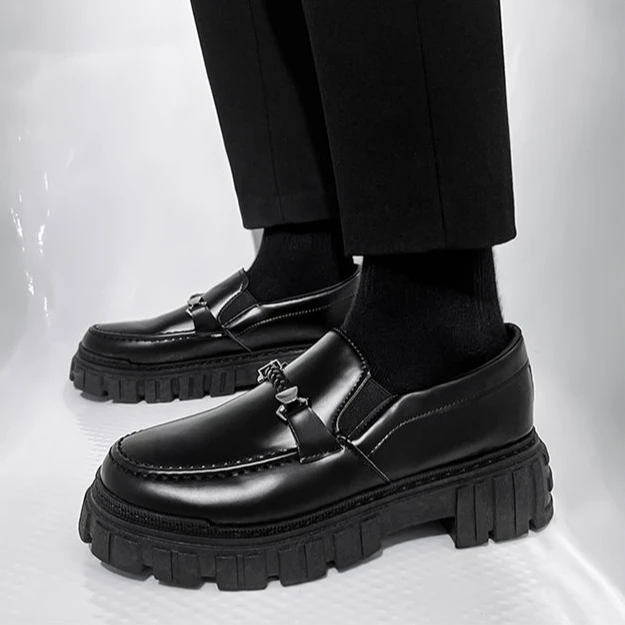The Importance of Comfort in Formal Footwear
Choosing the right comfortable formal shoes is not just about style. Comfort is crucial, especially for professionals who spend long hours on their feet. A shoe that pinches, rubs, or does not provide adequate support can not only cause pain and discomfort but also lead to long-term foot problems.

When we talk about comfort in formal footwear, it involves various factors. These include the fit of the shoe, the support offered by its insole, the flexibility of the sole, and the breathability of the materials used. Each aspect plays a vital role in how comfortable the shoe feels throughout the day. A lack of comfort in any of these areas can impact your posture, productivity, and overall well-being.
Moreover, professionals need to consider the implications of uncomfortable shoes on their work performance. Discomfort can lead to distraction, a decrease in concentration, and even a grimace that doesn’t go unnoticed during important meetings or presentations. Thus, comfortable formal shoes are essential not just for your feet’s sake but for maintaining a confident, professional demeanor.
Understanding the importance of comfort in formal footwear guides professionals towards making informed choices. It influences the criteria for selecting the best comfortable formal shoes, ensuring a harmony between elegance and comfort on professional grounds.
Criteria for Choosing Comfortable Formal Shoes
Selecting comfortable formal shoes requires attention to several key criteria. To start, a proper fit is paramount. Shoes that are too tight or too loose can cause blisters and discomfort. Measure your feet each time you buy shoes, as foot size can change over time. Second, look for good arch support. Insoles should stabilize the foot and reduce strain. Third, prioritize flexibility in the sole. Shoes should allow for natural movement of the feet. The next criterion is breathability—materials like leather and canvas help keep feet dry. Lastly, consider the cushioning. Adequate padding reduces impact on the feet during long days.
When shopping for comfortable formal shoes, keep these points in mind:
- Ensure a snug fit that allows some room for your toes.
- Check for insoles that support the arch of your feet.
- Test the sole’s flexibility by bending the shoe.
- Look for breathable materials to prevent sweaty feet.
- Feel the inside for cushioning that comforts throughout the day.
By following these criteria, professionals can find shoes that blend comfort with formality, making long work days more bearable.
Top Features to Look for in Comfortable Professional Shoes
When looking for the best comfortable formal shoes, consider key features that enhance comfort. First, a padded insole is essential. It cushions the foot and reduces strain on the heel. Next, a non-slip outsole provides stability and prevents falls. It’s vital for safety, especially on smooth surfaces.
Select shoes with a sturdy heel counter. This feature helps keep the heel in place and supports walking. Also, look for a roomy toe box. It gives toes space to move, avoiding cramps and pressure. Durable construction means the shoes will last longer, even with daily wear.
Choose shoes with laces or straps for a customizable fit. They allow you to adjust the tightness as needed. A lightweight design prevents fatigue from carrying extra weight on the feet. Finally, opt for shoes with a supportive midsole. It will give arch support and improve comfort for long hours.
Let’s sum up the top features:
- Padded insole for cushioning.
- Non-slip outsole for stability.
- Sturdy heel counter for support.
- Roomy toe box for comfort.
- Durable construction for longevity.
- Laces or straps for a perfect fit.
- Lightweight design for less fatigue.
- Supportive midsole for arch support.
Keep these in mind to ensure you get the most comfortable formal shoes for work.

Style Meets Comfort: Best Materials and Designs
When searching for comfortable formal shoes, materials and design play a key role. Leather is a go-to choice for many professionals. It offers durability and breathability, adapting to foot shape over time. Another excellent material is suede, known for its softness and plush feel. However, it requires more care to maintain its look. For vegans or those seeking an ethical option, high-quality synthetic materials are available.
Design-wise, classic shapes with a slight twist can provide both style and comfort. Oxfords and Derbys remain timeless, with lace-up fronts that adjust for the perfect fit. Instead of pointed toes, opt for almond-shaped or slightly rounded toe boxes. They allow for more toe room, eliminating excess pressure. Slip-on designs with elasticated sides or buckles also offer both ease and elegance.
The design can also hint at hidden comforts. For example, shoes with a discreet elastic gusset accommodate wider feet or high insteps. Select designs with padded collars and tongues to avoid chafing around the ankles. Seek out shoes with a slight heel elevation. This can improve posture and reduce strain on the legs.
In summary, choose materials like leather or high-quality synthetics for longevity and breathability. Designs should combine classic elegance with modern features that boost comfort. Look for:
- Durable materials like leather or ethical synthetics.
- Timeless designs with adjustable features.
- Roomy toe boxes for comfort.
- Hidden comforts, such as elastic gussets.
- Padded collars and tongues for less chafing.
- Slight heel elevation for better posture.
Selecting formal shoes that marry style with comfort ensures you look good without sacrificing your well-being.
Caring for Your Comfortable Formal Shoes
After investing in comfortable formal shoes, proper care is key to maintaining their condition and comfort. Here are actions you can take to extend the life and appearance of shoes:
- Clean Regularly: Wipe off dirt and dust with a soft cloth after each use. Leather shoes may need special cleaners and conditioners.
- Dry Properly: If shoes get wet, let them air dry away from direct heat. Stuffing with newspaper helps absorb moisture.
- Store Correctly: Keep shoes in a cool, dry place. Use shoe trees to maintain the shape.
- Rotate Your Shoes: Don’t wear the same pair every day. Rotating allows them to rest and retain their shape.
- Repair Timely: Fix scuffs, loose heels, or worn soles quickly. Delays can worsen the damage and reduce comfort.
By performing these simple care steps, you’ll ensure your comfortable formal shoes stay supportive and stylish for many professional engagements to come.
Popular Brands and Models of Comfortable Formal Shoes
Professionals seeking the perfect blend of style and comfort often turn to trusted brands. These brands have built reputations for creating comfortable formal shoes without skimping on elegance. Let’s look at some popular brands and their notable models:
- Clarks: Known for their cushioned insoles and reliable support. Their Tilden Walk Oxford is a standout for all-day comfort.
- Cole Haan: Combines innovation with classic styles. The Zerogrand series offers a modern twist on traditional design and superb comfort.
- ECCO: Renowned for durable and comfortable shoes. The Helsinki Slip-On is a favorite for its easy-going fit and supportive sole.
- Rockport: Offers shoes with total motion technology. The Style Leader 2 Bike Slip-On is praised for its cushioning and flexibility.
- Allen Edmonds: A classic choice for timeless design. The Park Avenue Oxford is a symbol of refinement with built-in comfort features.
Each of these brands offers features like padded insoles, supportive midsoles, and flexible outsoles, ticking all boxes of comfort. While choosing a brand, consider your specific needs and the features that will best serve your feet. Whether it’s a cushioned sole for standing all day or a wide toe box for extra space, there’s a shoe out there to provide both the professional look and the comfort you need to get through your workday with ease.
Tips for Shopping for Formal Shoes with Comfort in Mind
When shopping for comfortable formal shoes, keep in mind a few simple yet essential tips. First, never compromise on the fit. Shoes should feel good from the start, with no ‘breaking-in’ period required. If they pinch or rub in the store, they’ll do the same when you’re at work.
Second, shop later in the day when your feet are naturally a bit larger. This trick helps ensure a comfortable fit throughout your workday. Also, don’t forget to bring the type of socks you’ll typically wear with your formal shoes when you try them on. This gives you the most accurate sense of the shoe’s true fit.
Third, walk around the store in the shoes. This test drive is crucial. If they aren’t comfortable in the store, they won’t be at work. Check for ample toe room and heel support. Also, keep tabs on any slipping or chafing.
Keep an eye out for good return policies. If the shoes don’t work out, you should be able to return them without hassle. Shoes might feel great at first but show their true colors after a day at the office.
Lastly, consider the insole. Sometimes, the perfect shoe needs a little boost. If the shoes check all other boxes but are just shy on cushioning, consider adding a high-quality insole.
Remember these tips:
- Ensure immediate comfort; no break-in needed.
- Shop in the afternoon, wearing typical socks.
- Walk around to test for comfort.
- Look for stores with friendly return policies.
- Consider adding an insole for additional support.
By keeping these tips at the forefront, you can find the ideal comfortable formal shoes that won’t let you down during those long hours at work.
When Comfort Meets Dress Code: Balancing Professionalism and Comfort
Finding comfortable formal shoes that meet dress code standards can be a challenge. The right footwear should both look professional and feel comfortable. To maintain a polished appearance while ensuring comfort, consider these points:
- Select Appropriate Styles: Choose shoes that fit the formality of your workplace. Classic designs like Oxfords and loafers are usually safe bets.
- Mind the Material: Leather and high-grade synthetics are both professional and comfortable. They can mold to the shape of your feet over time.
- Opt for Neutral Colors: Black, brown, and navy are versatile and accepted in most professional settings.
- Pay Attention to Detail: Small comfort features in design can make a big difference. Look for padded insoles and arch support.
- Test for Flexibility: Firm shoes can seem formal but may not be comfortable. Shoes should have some flexibility to ease movement.
When dressing for work, it’s important to consider the message your footwear sends. Shoes should complement your attire and not distract from your professionalism. At the same time, they must be practical for long hours of wear. Strike a balance – your feet and your professional image will thank you.
By paying attention to style, material, color, and comfort features, you can confidently navigate your work environment. You don’t have to sacrifice comfort to meet the dress code. With the right pair of comfortable formal shoes, you can have the best of both worlds.
